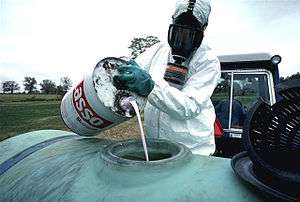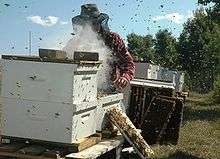Biological pest control
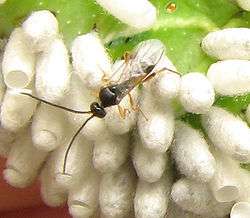
Biological control is a method of controlling pests such as insects, mites, weeds and plant diseases using other organisms.[1] It relies on predation, parasitism, herbivory, or other natural mechanisms, but typically also involves an active human management role. It can be an important component of integrated pest management (IPM) programs.
There are three basic types of biological pest control strategies: importation (sometimes called classical biological control), in which a natural enemy of a pest is introduced in the hope of achieving control; augmentation, in which locally-occurring natural enemies are bred and released to improve control; and conservation, in which measures are taken to increase natural enemies, such as by planting nectar-producing crop plants in the borders of rice fields.
Natural enemies of insect pests, also known as biological control agents, include predators, parasitoids, and pathogens. Biological control agents of plant diseases are most often referred to as antagonists. Biological control agents of weeds include seed predators, herbivores and plant pathogens.
Biological control can have side-effects on biodiversity through predation, parasitism, pathogenicity, competition, or other attacks on non-target species, especially when a species is introduced without thorough understanding of the possible consequences.
History
The term "biological control" was first used by Harry Scott Smith at the 1919 meeting of the Pacific Slope Branch of the American Association of Economic Entomologists, at the Mission Inn in downtown Riverside, California,[2] and later defined by P. DeBach and K. S. Hagen in 1964.[3] However, the practice has previously been used for centuries. The first report of the use of an insect species to control an insect pest comes from “Nan Fang Cao Mu Zhuang” (南方草木狀 Plants of the Southern Regions) (ca. 304 AD), which is attributed to Western Jin dynasty botanist Ji Han (嵇含, 263-307), in which it is mentioned that “Jiaozhi people sell ants and their nests attached to twigs looking like thin cotton envelopes, the reddish-yellow ant being larger than normal. Without such ants, southern citrus fruits will be severely insect-damaged”.[4] The ants used are known as huang gan (huang = yellow, gan = citrus) ants (Oecophylla smaragdina). The practice was later reported by Ling Biao Lu Yi (late Tang Dynasty or Early Five Dynasties), in Ji Le Pian by Zhuang Jisu (Southern Song Dynasty), in the Book of Tree Planting by Yu Zhen Mu (Ming Dynasty), in the book Guangdong Xing Yu (17th century), Lingnan by Wu Zhen Fang (Qing Dynasty), in Nanyue Miscellanies by Li Diao Yuan, and others.[4]
Biological control techniques as we know them today started to emerge in the 1870s. During this decade, in the USA, the Missouri State Entomologist C. V. Riley and the Illinois State Entomologist W. LeBaron began within-state redistribution of parasitoids to control crop pests. The first international shipment of an insect as biological control agent was made by Charles V. Riley in 1873, shipping to France the predatory mites Tyroglyphus phylloxera to help fight the grapevine phylloxera (Daktulosphaira vitifoliae) that was destroying grapevines in France. The United States Department of Agriculture (USDA) initiated research in classical biological control following the establishment of the Division of Entomology in 1881, with C. V. Riley as Chief. The first importation of a parasitoid into the United States was this of Cotesia glomerata in 1883-1884, imported from Europe to control the imported cabbage white butterfly, Pieris rapae. In 1888-1889 the vedalia beetle, Rodolia cardinalis, which is a ladybug, was introduced from Australia to California to control the cottony cushion scale, Icerya purchasi. This had become a major problem for the newly developed citrus industry in California, and by the end of 1889 the cottony cushion scale population had already declined. This great success led to further introductions of beneficial insects into the USA.[5]
In 1905 the USDA initiated its first large-scale biological control program, sending entomologists to Europe and Japan to look for natural enemies of the gypsy moth, Lymantria dispar dispar, and brown-tail moth, Euproctis chrysorrhoea, invasive pests of trees and shrubs. As a result, nine parasitoids of gypsy moth, seven of brown-tail moth, and two predators for both moths became established in the USA. Although the gypsy moth was not fully controlled by these natural enemies, the frequency, duration, and severity of its outbreaks were reduced and the program was regarded as successful. This program also led to the development of many concepts, principles, and procedures for the implementation of biological control programs.[5]
The first reported case of a classical biological control attempt in Canada involves the hymenopteran parasitoid Trichogramma minutum. Individuals were caught in New York State and released in Ontario gardens in 1882 by William Saunders, trained chemist and first Director of the Dominion Experimental Farms, for controlling the imported currantworm Nematus ribesii. Between 1884 and 1908, the first Dominion Entomologist, James Fletcher, continued introductions of other parasitoids and pathogens for the control of pests in Canada.[6]
Types of biological pest control
There are three basic biological pest control strategies: importation (classical biological control), augmentation and conservation.[7]
Importation
.jpg)
Importation or classical biological control involves the introduction of a pest's natural enemies to a new locale where they do not occur naturally. Early instances were often unofficial and not based on research, and some introduced species became serious pests themselves.[8]
To be most effective at controlling a pest, a biological control agent requires a colonizing ability which allows it to keep pace with the spatial and temporal disruption of the habitat. Control is greatest if the agent has temporal persistence, so that it can maintain its population even in the temporary absence of the target species, and if it is an opportunistic forager, enabling it to rapidly exploit a pest population.[9]
Joseph Needham noted a Chinese text dating from 304 AD, Records of the Plants and Trees of the Southern Regions, by Hsi Han, which describes mandarin oranges protected by large reddish-yellow citrus ants which attack and kill insect pests of the orange trees. The citrus ant (Oecophylla smaragdina)[10] was rediscovered in the 20th century, and since 1958 has been used in China to protect orange groves.[11]
One of the earliest successes in the west was in controlling Icerya purchasi (cottony cushion scale) in Australia, using a predatory insect Rodolia cardinalis (the vedalia beetle). This success was repeated in California using the beetle and a parasitoid fly, Cryptochaetum iceryae.[12]
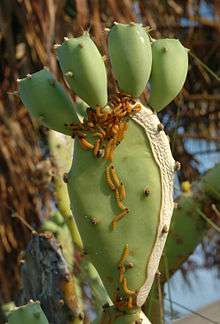
Prickly pear cacti were introduced into Queensland, Australia as ornamental plants. They quickly spread to cover over 25 million hectares of Australia. Two control agents were used to help control the spread of the plant, the cactus moth Cactoblastis cactorum, and Dactylopius scale insects.[13]
Damage from Hypera postica, the alfalfa weevil, a serious introduced pest of forage, was substantially reduced by the introduction of natural enemies. 20 years after their introduction the population of weevils in the alfalfa area treated for alfalfa weevil in the Northeastern United States remained 75 percent down.[14]

Alligator weed was introduced to the United States from South America. It takes root in shallow water, interfering with navigation, irrigation, and flood control. The alligator weed flea beetle and two other biological controls were released in Florida, enabling the state to ban the use of herbicides to control alligator weed three years later.[15] Another aquatic weed, the giant salvinia (Salvinia molesta) is a serious pest, covering waterways, reducing water flow and harming native species. Control with the salvinia weevil (Cyrtobagous salviniae) is effective in warm climates,[16] and in Zimbabwe, a 99% control of the weed was obtained over a two-year period.[17]
Small commercially reared parasitoidal wasps,[7] Trichogramma ostriniae, provide limited and erratic control of the European corn borer (Ostrinia nubilalis), a serious pest. Careful formulations of the bacterium Bacillus thuringiensis are more effective.[18]
The population of Levuana iridescens, the Levuana moth, a serious coconut pest in Fiji, was brought under control by a classical biological control program in the 1920s.[19]
Augmentation

Augmentation involves the supplemental release of natural enemies, boosting the naturally occurring population. In inoculative release, small numbers of the control agents are released at intervals to allow them to reproduce, in the hope of setting up longer-term control, and thus keeping the pest down to a low level, constituting prevention rather than cure. In inundative release, in contrast, large numbers are released in the hope of rapidly reducing a damaging pest population, correcting a problem that has already arisen. Augmentation can be effective, but is not guaranteed to work, and relies on understanding of the situation.[20]
An example of inoculative release occurs in greenhouse production of several crops. Periodic releases of the parasitoid, Encarsia formosa, are used to control greenhouse whitefly,[21] while the predatory mite Phytoseiulus persimilis is used for control of the two-spotted spider mite.[22]
The egg parasite Trichogramma is frequently released inundatively to control harmful moths. Similarly, Bacillus thuringiensis and other microbial insecticides are similarly used in large enough quantities for a rapid effect.[20] Recommended release rates for Trichogramma in vegetable or field crops range from 5,000 to 200,000 per acre (1 to 50 per square metre) per week according to the level of pest infestation.[23] Similarly, entomopathogenic nematodes are released at rates of millions and even billions per acre for control of certain soil-dwelling insect pests.[24]
Conservation
The conservation of existing natural enemies in an environment is the third method of biological pest control.[25] Natural enemies are already adapted to the habitat and to the target pest, and their conservation can be simple and cost-effective, as when nectar-producing crop plants are grown in the borders of rice fields. These provide nectar to support parasitoids and predators of planthopper pests and have been demonstrated to be so effective (reducing pest densities by 10- or even 100-fold) that farmers sprayed 70% less insecticides, enjoyed yields boosted by 5%, and this led to an economic advantage of 7.5%.[26] Predators of aphids were similarly found to be present in tussock grasses by field boundary hedges in England, but they spread too slowly to reach the centres of fields. Control was improved by planting a metre-wide strip of tussock grasses in field centres, enabling aphid predators to overwinter there.[25]
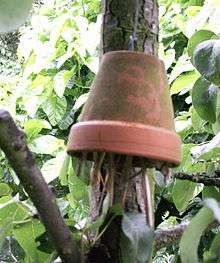
Cropping systems can be modified to favor natural enemies, a practice sometimes referred to as habitat manipulation. Providing a suitable habitat, such as a shelterbelt, hedgerow, or beetle bank where beneficial insects can live and reproduce, can help ensure the survival of populations of natural enemies. Things as simple as leaving a layer of fallen leaves or mulch in place provides a suitable food source for worms and provides a shelter for insects, in turn being a food source for such beneficial mammals as hedgehogs and shrews. Compost piles and stacks of wood can provide shelter for invertebrates and small mammals. Long grass and ponds support amphibians. Not removing dead annuals and non-hardy plants in the autumn allows insects to make use of their hollow stems during winter.[27] In California, prune trees are sometimes planted in grape vineyards to provide an improved overwintering habitat or refuge for a key grape pest parasitoid.[28] The providing of artificial shelters in the form of wooden caskets, boxes or flowerpots is also sometimes undertaken, particularly in gardens, to make a cropped area more attractive to natural enemies. For example, earwigs are natural predators which can be encouraged in gardens by hanging upside-down flowerpots filled with straw or wood wool. Green lacewings can be encouraged by using plastic bottles with an open bottom and a roll of cardboard inside. Birdhouses enable insectivorous birds to nest; the most useful birds can be attracted by choosing an opening just large enough for the desired species.[27]
Biological control agents
Predators
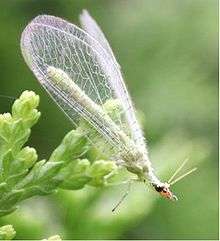
Predators are mainly free-living species that directly consume a large number of prey during their whole lifetime. Ladybugs, and in particular their larvae which are active between May and July in the northern hemisphere, are voracious predators of aphids, and also consume mites, scale insects and small caterpillars. The spotted lady beetle (Coleomegilla maculata) is also able to feed on the eggs and larvae of the Colorado potato beetle (Leptinotarsa decemlineata).[29]
The larvae of many hoverfly species principally feed upon greenfly (aphids), one larva devouring up to 400 in its lifetime. Their effectiveness in commercial crops has not been studied.[30]
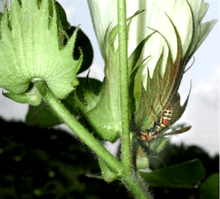
Several species of entomopathogenic nematode are important predators of insect and other invertebrate pests.[31] Phasmarhabditis hermaphrodita is a microscopic nematode that kills slugs. Its complex life cycle include a free-living, infective stage in the soil where it becomes associated with a pathogenic bacteria such as Moraxella osloensis. The nematode enters the slug through the posterior mantle region, thereafter feeding and reproducing inside, but it is the bacteria that kill the slug. The nematode is available commercially in Europe and is applied by watering onto moist soil.[32]
Species used to control spider mites include the predatory mites Phytoseiulus persimilis,[33] Neoseilus californicus,[34] and Amblyseius cucumeris, the predatory midge Feltiella acarisuga,[34] and a ladybird Stethorus punctillum.[34] The bug Orius insidiosus has been successfully used against the two-spotted spider mite and the western flower thrips (Frankliniella occidentalis).[35]
Parasitoids
Parasitoids lay their eggs on or in the body of an insect host, which is then used as a food for developing larvae. The host is ultimately killed. Most insect parasitoids are wasps or flies, and may have a very narrow host range. The most important groups are the ichneumonid wasps, which prey mainly on caterpillars of butterflies and moths; braconid wasps, which attack caterpillars and a wide range of other insects including greenfly; chalcid wasps, which parasitize eggs and larvae of greenfly, whitefly, cabbage caterpillars, and scale insects; and tachinid flies, which parasitize a wide range of insects including caterpillars, adult and larval beetles, and true bugs.[36]
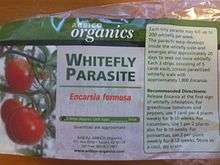
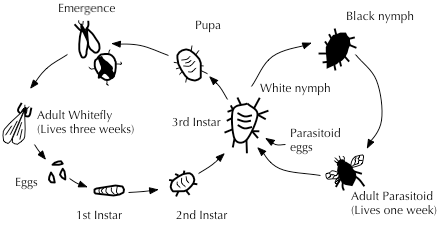
Encarsia formosa is a small predatory chalcid wasp which is a parasitoid of whitefly, a sap-feeding insect which can cause wilting and black sooty moulds in glasshouse vegetable and ornamental crops. It is most effective when dealing with low level infestations, giving protection over a long period of time. The wasp lays its eggs in young whitefly 'scales', turning them black as the parasite larvae pupates.[21] Gonatocerus ashmeadi (Hymenoptera: Mymaridae) has been introduced to control the glassy-winged sharpshooter Homalodisca vitripennis (Hemipterae: Cicadellidae) in French Polynesia and has successfully controlled ~95% of the pest density.[37]
Parasitoids are among the most widely used biological control agents. Commercially, there are two types of rearing systems: short-term daily output with high production of parasitoids per day, and long-term low daily output with a range in production of 4-1000million female parasitoids per week.[38] Larger production facilities produce on a yearlong basis, whereas some facilities produce only seasonally. Rearing facilities are usually a significant distance from where the agents are to be used in the field, and transporting the parasitoids from the point of production to the point of use can pose problems.[39] Shipping conditions can be too hot, and even vibrations from planes or trucks can adversely affect parasitoids.[38]
Pathogens
Pathogenic micro-organisms include bacteria, fungi, and viruses. They kill or debilitate their host and are relatively host-specific. Various microbial insect diseases occur naturally, but may also be used as biological pesticides. When naturally occurring, these outbreaks are density-dependent in that they generally only occur as insect populations become denser.
Bacteria
Bacteria used for biological control infect insects via their digestive tracts, so they offer only limited options for controlling insects with sucking mouth parts such as aphids and scale insects.[40] Bacillus thuringiensis is the most widely applied species of bacteria used for biological control, with at least four sub-species used against Lepidopteran (moth, butterfly), Coleopteran (beetle) and Dipteran (true fly) insect pests. The bacterium is available in sachets of dried spores which are mixed with water and sprayed onto vulnerable plants such as brassicas and fruit trees.[41] B. thuringiensis has also been incorporated into crops, making them resistant to these pests and thus reducing the use of pesticides.[42] The bacterium Paenibacillus popilliae causes milky spore disease has been found useful in the control of Japanese beetle, killing the larvae. It is very specific to its host species and is harmless to vertebrates and other invertebrates.[43]
Fungi
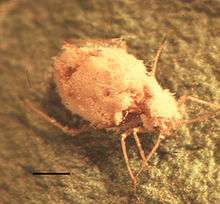
Entomopathogenic fungi, which cause disease in insects, include at least 14 species that attack aphids.[44] Beauveria bassiana is mass-produced and used to manage a wide variety of insect pests including whiteflies, thrips, aphids and weevils.[45] Lecanicillium spp. are deployed against white flies, thrips and aphids. Metarhizium spp. are used against pests including beetles, locusts and other grasshoppers, Hemiptera, and spider mites. Paecilomyces fumosoroseus is effective against white flies, thrips and aphids; Purpureocillium lilacinus is used against root-knot nematodes, and 89 Trichoderma species against certain plant pathogens. Trichoderma viride has been used against Dutch elm disease, and has shown some effect in suppressing silver leaf, a disease of stone fruits caused by the pathogenic fungus Chondrostereum purpureum.[46]
The fungi Cordyceps and Metacordyceps are deployed against a wide spectrum of arthropods. Entomophaga is effective against pests such as the green peach aphid.[47]
Several members of Chytridiomycota and Blastocladiomycota have been explored as agents of biological control.[48][49][50] From Chytridiomycota, Synchytrium solstitiale is being considered as a control agent of the yellow star thistle (Centaurea solstitialis) in the United States.[51]
Viruses
Baculoviruses are specific to individual insect host species and have been shown to be useful in biological pest control. For example, the Lymantria dispar multicapsid nuclear polyhedrosis virus has been used to spray large areas of forest in North America where larvae of the gypsy moth are causing serious defoliation. The moth larvae are killed by the virus they have eaten and die, the disintegrating cadavers leaving virus particles on the foliage to infect other larvae.[52]
A mammalian virus, the rabbit haemorrhagic disease virus has been introduced to Australia and to New Zealand to attempt to control the European rabbit populations there.[53]
Algae
Lagenidium giganteum is a water-borne mould that parasitizes the larval stage of mosquitoes. When applied to water, the motile spores avoid unsuitable host species and search out suitable mosquito larval hosts. This alga has the advantages of a dormant phase, resistant to desiccation, with slow-release characteristics over several years. Unfortunately, it is susceptible to many chemicals used in mosquito abatement programmes.[54]
Plants
The legume vine Mucuna pruriens is used in the countries of Benin and Vietnam as a biological control for problematic Imperata cylindrica grass. Mucuna pruriens is said not to be invasive outside its cultivated area.[55] Desmodium uncinatum can be used in push-pull farming to stop the parasitic plant, Striga.[56]
Other methods
Combined use of parasitoids and pathogens
In cases of massive and severe infection of invasive pests, techniques of pest control are often used in combination. An example is the emerald ash borer, Agrilus planipennis, an invasive beetle from China, which has destroyed tens of millions of ash trees in its introduced range in North America. As part of the campaign against it, from 2003 American scientists and the Chinese Academy of Forestry searched for its natural enemies in the wild, leading to the discovery of several parasitoid wasps, namely Tetrastichus planipennisi, a gregarious larval endoparasitoid,Oobius agrili, a solitary, parthenogenic egg parasitoid, and Spathius agrili, a gregarious larval ectoparasitoid. These have been introduced and released into the United States of America as a possible biological control of the emerald ash borer. Initial results have shown promise with Tetrastichus planipennisi and it is now being released along with Beauveria bassiana, a fungal pathogen with known insecticidal properties.[57][58][59]
Indirect control
Pests may be controlled by biological control agents that do not prey directly upon them. For example, the Australian bush fly, Musca vetustissima, is a major nuisance pest in Australia, but native decomposers found in Australia are not adapted to feeding on cow dung, which is where bush flies breed. Therefore, the Australian Dung Beetle Project (1965–1985), led by Dr. George Bornemissza of the Commonwealth Scientific and Industrial Research Organisation, released forty-nine species of dung beetle, with the aim of reducing the amount of dung and therefore also the potential breeding sites of the fly.[60]
Side-effects
Biological control can affect biodiversity[9] through predation, parasitism, pathogenicity, competition, or other attacks on non-target species.[61] An introduced control does not always target only the intended pest species; it can also target native species.[62] In Hawaii during the 1940s parasitic wasps were introduced to control a lepidopteran pest and the wasps are still found there today. This may have a negative impact on the native ecosystem, however, host range and impacts need to be studied before declaring their impact on the environment.[63]
Vertebrate animals tend to be generalist feeders, and seldom make good biological control agents; many of the classic cases of "biocontrol gone awry" involve vertebrates. For example, the cane toad (Bufo marinus) was intentionally introduced to Australia to control the greyback cane beetle (Dermolepida albohirtum),[64] and other pests of sugar cane. 102 toads were obtained from Hawaii and bred in captivity to increase their numbers until they were released into the sugar cane fields of the tropic north in 1935. It was later discovered that the toads could not jump very high and so were unable to eat the cane beetles which stayed up on the upper stalks of the cane plants. However the toad thrived by feeding on other insects and it soon spread very rapidly; it took over native amphibian habitat and brought foreign disease to native toads and frogs, dramatically reducing their populations. Also when it is threatened or handled, the cane toad releases poison from parotoid glands on its shoulders; native Australian species such as goannas, tiger snakes, dingos and northern quolls that attempted to eat the toad were harmed or killed. However, there has been some recent evidence that native predators are adapting, both physiologically and through changing their behaviour, so in the long run, their populations may recover.[65]
Rhinocyllus conicus, a seed-feeding weevil, was introduced to North America to control exotic musk thistle (Carduus nutans) and Canadian thistle (Cirsium arvense). However the weevil also attacks native thistles, harming such species as the endemic Platte thistle (Cirsium neomexicanum) by selecting larger plants (which reduced the gene pool), reducing seed production and ultimately threatening the species' survival.[66]
The small Asian mongoose (Herpestus javanicus) was introduced to Hawaii in order to control the rat population. However it was diurnal and the rats emerged at night, and it preyed on the endemic birds of Hawaii, especially their eggs, more often than it ate the rats, and now both rats and mongooses threaten the birds. This introduction was undertaken without understanding the consequences of such an action. No regulations existed at the time, and more careful evaluation should prevent such releases now.[67]
The sturdy and prolific eastern mosquitofish (Gambusia holbrooki) is a native of the southeastern United States and was introduced around the world in the 1930s and 40s to feed on mosquito larvae and thus combat malaria. However, it has thrived at the expense of local species, causing a decline of endemic fish and frogs through competition for food resources, as well as through eating their eggs and larvae.[68] In Australia, the mosquitofish is the subject of discussion as to how best to control it; in 1989 it was said that "biological population control is well beyond present capabilities", and this remains the position.[69]
Grower education
A potential obstacle to the adoption of biological pest control measures is growers sticking to the familiar use of pesticides. It has been claimed that many of the pests that are controlled today using pesticides, actually became pests because pesticide use reduced or eliminated natural predators.[70] A method of increasing grower adoption of biocontrol involves is letting growers learn by doing, for example showing them simple field experiments, having observations of live predation of pests, or collections of parasitised pests. In the Philippines, early season sprays against leaf folder caterpillars were common practice, but growers were asked to follow a 'rule of thumb' of not spraying against leaf folders for the first 30 days after transplanting; participation in this resulted in a reduction of insecticide use by 1/3 and a change in grower perception of insecticide use.[71]
See also
- Association of Natural Biocontrol Producers
- Beneficial insects
- Biological pesticide
- Chitosan
- Companion planting
- Insectary plants
- International Organization for Biological Control
- Inundative application
- Japanese beetle
- Mating disruption
- Nematophagous fungus
- Organic gardening
- Organic farming
- Pest control
- Permaculture zone 5
- Sterile insect technique
- Sustainable farming
- Sustainable gardening
References
- ↑ Flint, Maria Louise & Dreistadt, Steve H. (1998). Clark, Jack K., ed. Natural Enemies Handbook: The Illustrated Guide to Biological Pest Control. University of California Press. ISBN 978-0-520-21801-7.
- ↑ Biological Control: Harry Smith Fund
- ↑ DeBach P., Hagen K. S., 1964. Manipulation of entomophagous species , p. 429-458. In: P. DeBach (Ed.), Biological control of insect pests and weeds. Reinhold, New York, 844 pp.
- 1 2 http://http-server.carleton.ca/~bgordon/Rice/papers/peng83.htm
- 1 2 Coulson J. R., Vail P. V., Dix M. E., Nordlund D. A., Kauffman W. C., Eds. 2000. 110 years of biological control research and development in the United States Department of Agriculture: 1883-1993. U.S. Department of Agriculture, Agricultural research Service 645 pp.
- ↑ McLeod J. H., McGugan B. M., Coppel H. C., 1962. A Review of the Biological Control Attempts Against Insects and Weeds in Canada. Technical Communication No. 2. Commonwealth Agricultural Bureau. Reading: England, 216 pp.
- 1 2 "What is Biological Control?". Cornell University. Retrieved 7 June 2016.
- ↑ "Classical Biological Control: Importation of New Natural Enemies". University of Wisconsin. Retrieved 7 June 2016.
- 1 2 Follett PA, Duan JJ (2000) 'Nontarget effects of biological control.' (Kluwer Academic Publishers).
- ↑ Huang, H. T.; Yang, Pei (October 1987). "The Ancient Cultured Citrus Ant". BioScience. 37 (9): 665–671. doi:10.2307/1310713. JSTOR 1310713.
- ↑ "The Chinese Scientific Genius. Discoveries and inventions of an ancient civilization: Biological Pest Control" (PDF). The Courier. UNESCO: 24. October 1988. Retrieved 5 June 2016.
- ↑ "How to Manage Pests. Cottony Cushion Scale". University of California Integrated Pest Management. Retrieved 5 June 2016.
- ↑ "The Prickly Pear Story" (PDF). Department of Agriculture and Fisheries, Queensland. Retrieved 7 June 2016.
- ↑ "How to Manage Pests. Alfalfa". University of California Integrated Pest Management. Retrieved 5 June 2016.
- ↑ Cofrancesco (2007)
- ↑ "Salvinia (Salvinia molesta)" (PDF). CRC Weed Management. Retrieved 7 June 2016.
- ↑ Chikwenhere, Godfrey P.; Keswani, C. L. (1997). "Economics of biological control of Kariba weed (Salvinia molesta Mitchell) at Tengwe in north-western Zimbabwe: a case study". International Journal of Pest Management. 43 (2): 109–112. doi:10.1080/096708797228780.
- ↑ "Featured Creatures. European corn borer". University of Florida IFAS. Retrieved 5 June 2016.
- ↑ Kuris, Armand M. (March 2003). "Did biological control cause extinction of the coconut moth, Levuana iridescens, in Fiji?". Biological Invasions. 5 (1): 133–141.
- 1 2 "Augmentation: The Periodic Release of Natural Enemies". University of Wisconsin. Retrieved 7 June 2016.
- 1 2 Hoddle, M.S.; Van Driesche, R.G.; Sanderson, J.P. (1998). "Biology and Use of the Whitefly Parasitoid Encarsia Formosa". Annual Review of Entomology. 43: 645–669. doi:10.1146/annurev.ento.43.1.645.
- ↑ "Biological control. Phytoseiulus persimilis (Acarina: Phytoseiidae)". Cornell University. Retrieved 7 June 2016.
- ↑ Peter, K. V. (2009). Basics Of Horticulture. New India Publishing. p. 288. ISBN 978-81-89422-55-4.
- ↑ Shapiro-Ilan, David I; Gaugler, Randy. "Biological Control. Nematodes (Rhabditida: Steinernematidae & Heterorhabditidae)". Cornell University. Retrieved 7 June 2016.
- 1 2 "Conservation of Natural Enemies: Keeping Your "Livestock" Happy and Productive". University of Wisconsin. Retrieved 7 June 2016.
- ↑ Gurr, Geoff M. (22 February 2016). "Multi-country evidence that crop diversification promotes ecological intensification of agriculture". Nature Plants. doi:10.1038/nplants.2016.14.
- 1 2 Pauline Pears (2005), HDRA encyclopedia of organic gardening, Dorling Kindersley, ISBN 978-1405308915
- ↑ Wilson, L. Ted; Pickett, Charles H.; Flaherty, Donald L.; Bates, Teresa A. "French prune trees: refuge for grape leafhopper parasite" (PDF). University of California Davis. Retrieved 7 June 2016.
- ↑ Acorn, John (2007). Ladybugs of Alberta: Finding the Spots and Connecting the Dots. University of Alberta. p. 15. ISBN 978-0-88864-381-0.
- ↑ "Know Your Friends. Hover Flies". University of Wisconsin. Retrieved 7 June 2016.
- ↑ Kaya, Harry K.; et al. (1993). "An Overview of Insect-Parasitic and Entomopathogenic Nematodes". In Bedding, R.A. Nematodes and the Biological Control of Insect Pests. CSIRO Publishing. ISBN 978-0-643-10591-1.
- ↑ "Biological control: Phasmarhabditis hermaphrodita". Cornell University. Retrieved 15 June 2016.
- ↑ "Glasshouse red spider mite". Royal Horticultural Society. Retrieved 7 June 2016.
- 1 2 3 "Biological Control of Two- Spotted Spider Mites". University of Connecticut. Retrieved 7 June 2016.
- ↑ Xuenong Xu (2004). Combined Releases of Predators for Biological Control of Spider Mites Tetranychus urticae Koch and Western Flower Thrips Frankliniella occidentalis (Pergande). Cuvillier Verlag. p. 37. ISBN 978-3-86537-197-3.
- ↑ "Parasitoid Wasps (Hymenoptera)". University of Maryland. Retrieved 6 June 2016.
- ↑ Hoddle M.S.; Grandgirard J.; Petit J.; Roderick G.K.; Davies N. (2006). "Glassy-winged sharpshooter Ko'ed - First round - in French Polynesia". Biocontrol News and Information. 27 (3): 47N–62N.
- 1 2 Smith, S.M. (1996). "Biological control with Trichogramma: advances, successes, and potential of their use". Annual Review of Entomology. 41: 375–406. doi:10.1146/annurev.en.41.010196.002111. PMID 15012334.
- ↑ Wajnberg, E.; Hassan, S.A. (1994). Biological Control with Egg Parasitoids. CABI Publishing.
- ↑ L.A. Swan. 1964. Beneficial Insects. 1st ed. page 249.
- ↑ Lemaux, Peggy G. (2008). "Genetically Engineered Plants and Foods: A Scientist's Analysis of the Issues (Part I)". Annual Review of Plant Biology. 59: 771–812. doi:10.1146/annurev.arplant.58.032806.103840. PMID 18284373.
- ↑ Kumar, PA; Malik, VS; Sharma, RP (1996). "Insecticidal proteins of Bacillus thuringiensis". Advances in Applied Microbiology. 42: 1–43.
- ↑ "Biological control: Paenibacillus popilliae". Cornell University. Retrieved 15 June 2016.
- ↑ I.M. Hall & P.H. Dunn, Entomophthorous Fungi Parasitic on the Spotted Alfalfa Aphid, Hilgardia, Sept 1957.
- ↑ McNeil, Jim (2016). "Fungi for the biological control of insect pests". eXtension.org. Retrieved 6 June 2016.
- ↑ Fry, William E. (2012). Principles of Plant Disease Management. Academic Press. p. 187. ISBN 978-0-08-091830-3.
- ↑ Capinera, John L. (October 2005). "Featured creatures:". University of Florida website - Department of Entomology and Nematology. University of Florida. Retrieved 7 June 2016.
- ↑ Li, Z.; Dong, Q.; Albright, T.P.; Guo, Q. (2011). "Natural and human dimensions of a quasi-natural wild species: the case of kudzu". Biological Invasions. 13: 2167–2179. doi:10.1007/s10530-011-0042-7.
- ↑ Beard, Karen H., and Eric M. O'Neill. "Infection of an invasive frog Eleutherodactylus coqui by the chytrid fungus Batrachochytrium dendrobatidis in Hawaii." Biological Conservation 126.4 (2005): 591-595.
- ↑ Sparrow, F.K. (1960). Aquatic Phycomyetes (2nd ed.). University of Michigan Press.
- ↑ Voigt K., A.V. Marano, & F.H. Gleason. 2013. Ecological & Economical Importance of Parasitic Zoosporic True Fungi. in: The Mycota: A Comprehensive Treatise on Fungi as Experimental Systems for Basic & Applied Research Vol. 11 Agricultural Applications. 2nd edition Eds: K. Esser & F. Kempken. Springer. pp 243–270.
- ↑ D'Amico, Vince. "Biological control: Baculoviruses". Cornell University. Retrieved 15 June 2016.
- ↑ Abrantes, Joana; van der Loo, Wessel; Le Pendu, Jacques; Esteves, Pedro J. (2012). "Rabbit haemorrhagic disease (RHD) and rabbit haemorrhagic disease virus (RHDV): a review". Veterinary Research. 43 (12). doi:10.1186/1297-9716-43-12.
- ↑ Kerwin, James L. "Biological control: Lagenidium giganteum". Cornell University. Retrieved 15 June 2016.
- ↑ "Factsheet - Mucuna pruriens". www.tropicalforages.info. Retrieved 2008-05-21.
- ↑ Khan, Z.; Midega, C. A. O.; Amudavi, D. M.; Hassanali, A.; Pickett, J. A. (2008). "On-farm evaluation of the 'push–pull' technology for the control of stemborers and striga weed on maize in western Kenya". Field Crops Research. 106 (3): 224–233. doi:10.1016/j.fcr.2007.12.002.
- ↑ Gould, Juli; Bauer, Leah. "Biological Control of Emerald Ash Borer (Agrilus planipennis)" (PDF). Animal and Plant Health Inspection Service (APHIS) website. United States Department of Agriculture. Retrieved 28 April 2011. External link in
|work=(help) - ↑ Bauer, L.S.; Liu, H-P; Miller, D.; Gould, J. (2008). "Developing a classical biological control program for Agrilus planipennis (Coleoptera: Buprestidae), an invasive ash pest in North America" (PDF). Newsletter of the Michigan Entomological Society. 53 (3&4): 38–39. Retrieved 29 April 2011.
- ↑ "Biocontrol: Fungus and Wasps Released to Control Emerald Ash Borer". Science News. ScienceDaily. 26 April 2011. Retrieved 27 April 2011.
- ↑ Bornemissza, G. F. (1976). "The Australian dung beetle project 1965–1975". Australian Meat Research Committee Review. 30: 1–30.
- ↑ Council NR (1996) 'Ecologically Based Pest Management:New Solutions for a New Century.' (The National Academies Press)
- ↑ Society for Conservation Biology (2002), "Biocontrol backfires again," http://www.scienceblog.com/community/older/2002/C/20025043.html, accessed July 31, 2009.
- ↑ Wright, MG; Hoffmann, MP; Kuhar, TP; Gardner, J; Pitcher, SA (2005). "Evaluating risks of biological control introductions: A probabilistic risk-assessment approach". Biological Control. 35: 338–347. doi:10.1016/j.biocontrol.2005.02.002.
- ↑ "Cane Toad". Exotic Animals - Major Pests. Northern Territory Government, Australia. Retrieved 14 March 2011.
- ↑ "The cane toad (Bufo marinus)". Australian Government: Department of the Environment. 2010. Retrieved 2 July 2016.
- ↑ Rose, K. E.; Louda, S. M.; Rees, M. (2005). "Demographic and evolutionary impacts of native and invasive insect herbivores: a case study with Platte thistle, Cirsium canescens". Ecology. 86 (2): 453–465. doi:10.1890/03-0697.
- ↑ "Moving on from the mongoose: the success of biological control in Hawai'i". Kia‘i Moku. MISC. 18 April 2012. Retrieved 2 July 2016.
- ↑ National Research Council (U.S.). Board on Agriculture and Natural Resources (June 2000). Incorporating science, economics, and sociology in developing sanitary and phytosanitary standards in international trade: proceedings of a conference. National Academies Press. p. 97. ISBN 978-0-309-07090-4. Retrieved 12 August 2011.
- ↑ "Gambusia Control". Retrieved 2 July 2016.
- ↑ Thacker, J.R.M. 2002. An Introduction to Arthropod Pest Control. Cambridge University Press.
- ↑ Heong, K.L.; Escalada, M. M. (1998). "Changing rice farmers' pest management practices through participation in a small-scale experiment". Int. J. Pest Management. 44: 191–197. doi:10.1080/096708798228095.
Further reading
- General
- Wiedenmann, R. (2000). Introduction to Biological Control. Midwest Institute for Biological Control, Illinois.
- Cowie, R. H. (2001). "Can snails ever be effective and safe biocontrol agents?"." (PDF). International Journal of Pest Management. 47 (1): 23–40. doi:10.1080/09670870150215577.
- Cooksey D. 2002. Biological Control in Pest Management Systems of Plants. Western Regional Committee, Riverside, CA.
- R. James Cook (September 1993). "Making Greater Use of Introduced Microorganisms for Biological Control of Plant Pathogens". Annual Review of Phytopathology. 31 (1): 53–80. doi:10.1146/annurev.py.31.090193.000413. PMID 18643761.
- U.S. Congress, Office of Technology Assessment (1995). "Biologically based technologies for pest control" (PDF). OTA-ENV-636. US Government Printing Office, Washington, DC.
- Felix Wäckers; Paul van Rijn & Jan Bruin (2005). "Plant-Provided Food for Carnivorous Insects - a protective mutualism and its applications". Cambridge University Press, 2005. ISBN 978-0-521-81941-1.
- Effects on native biodiversity
- Pereira, M.J. et al. (1998) Conservation of natural vegetation in Azores Islands. Bol. Mus. Munic. Funchal 5, 299–305
- Weeden, C.R., A. M. Shelton, and M. P. Hoffman. Biological Control: A Guide to Natural Enemies in North America.
- Cane toad: a case study. 2003.
- Humphrey, J. and Hyatt. 2004. CSIRO Australian Animal Health Laboratory. Biological Control of the Cane Toad Bufo marinus in Australia
- Cory, J.; Myers, J. (2000). "Direct and indirect ecological effects of biological control". Trends in Ecology & Evolution. 15 (4): 137–139. doi:10.1016/s0169-5347(99)01807-8.
- Johnson, M. 2000. Nature and Scope of Biological Control. Biological Control of Pests.
- Effects on invasive species
- Cofrancesco, A. 2007. U.S. National Management Plan: An Action Plant for the Nation- Control and Management. Army Corps of Engineers.
- Economic effects
- Griffiths, G.J.K. 2007. Efficacy and economics of shelter habitats for conservation. Biological Control: in press. doi:10.1016/j.biocontrol.2007.09.002
- Collier T. and Steenwyka, R. 2003. A critical evaluation of augmentative biological control. Economics of augmentation: 31, 245-256.
External links
- Biological Pest Control, National Invasive Species Information Center, United States National Agricultural Library
- Biological fight applied to the South countries - 10-minute video
- Association of Natural Biocontrol Producers
- International Organization for Biological Control
- Use of ionizing radiation in biological control

